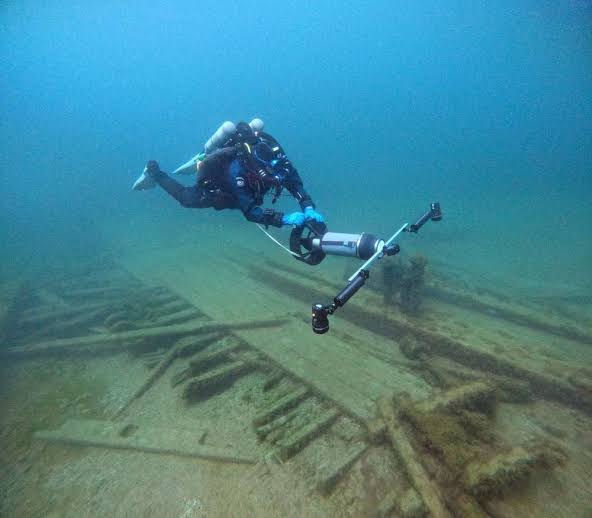In an exciting development for maritime archaeology, researchers have uncovered the wreck of the Margaret A. Muir, a schooner that sank in 1893. This significant find was made in May 2024, with the wreck lying in just 50 feet of water in Lake Michigan. The discovery adds a new chapter to the rich history of the Great Lakes, which are famous for the tragic shipwreck of the Edmund Fitzgerald in November 1975, immortalized by Gordon Lightfoot’s ballad.
The Margaret A. Muir was a wooden schooner, known for transporting goods like lumber and coal across the Great Lakes. Its exact fate had remained unknown for over a century until this recent discovery. What makes this find particularly remarkable is the preservation of the ship’s unique stepped sternpost construction. This rare feature provides valuable insights into the shipbuilding techniques of the late 19th century.

The Margaret A. Muir’s Stepped Sternpost: A Rare Glimpse into 19th-Century Shipbuilding
Tamara Thomsen, a maritime archaeologist from the State Historical Society of Wisconsin, led the team that discovered the wreck. Using advanced sonar technology and skilled diving, the team was able to capture detailed images of the schooner’s structure. The stepped sternpost, a distinctive design element, may have contributed to the vessel’s stability and handling, offering a fascinating glimpse into the engineering practices of the time.
While the Edmund Fitzgerald remains the most iconic Great Lakes shipwreck, the discovery of the Margaret A. Muir is generating considerable interest. The ship’s shallow resting place makes it accessible for exploration and study, providing a unique opportunity to learn more about the maritime history of the region. The Margaret A. Muir is now part of the Great Lakes Shipwreck Preservation Society’s extensive catalog, which aims to protect and study these underwater cultural treasures.
Plans are already underway to document and preserve the site, with the potential for creating digital reconstructions and virtual tours. This would allow a broader audience to experience the historical significance of the Margaret A. Muir, even if they cannot visit the site in person. The discovery underscores the importance of underwater archaeology and the preservation of maritime heritage, promising more exciting revelations from the depths of Lake Michigan.
As technology advances, the chances of uncovering more hidden stories from the Great Lakes increase, offering deeper insights into the region’s past. The Margaret A. Muir is a testament to the rich maritime history that lies beneath the surface, waiting to be explored.

Diver Examines the Preserved Hull of the 1893 Schooner Margaret A. Muir in Lake Michigan”
### The Margaret A. Muir, a Schooner Discovered in Lake Michigan in 1893
The amazing discovery of the **Margaret A. Muir** wreck, a schooner that went down in 1893, has been made by maritime archaeologists. The wreck, which was located in Lake Michigan at a depth of only 50 feet, was discovered in May 2024, marking a major archaeological find. A new chapter has been added to the Great Lakes’ storied past with this finding. The lakes are well-known for the terrible shipwreck of the Edmund Fitzgerald in November 1975, which was memorialized in a ballad by Gordon Lightfoot.
Among the many products transported by the wooden schooner Margaret A. Muir across the Great Lakes was coal. Previous to this latest finding, its precise destiny had been shrouded in mystery for more than a hundred years. The preservation of the ship’s distinctive stepped sternpost design is what makes this find truly impressive. Shipbuilding practices in the late 19th century can be better understood with the help of this unusual artifact.
The team that found the wreck was headed by maritime archaeologist Tamara Thomsen of the State Historical Society of Wisconsin. Capturing comprehensive photographs of the schooner’s structure was made possible by modern sonar equipment and competent diving. As an interesting window into the engineering methods of the day, the vessel’s stability and handling may have been aided by the stepped sternpost, a unique design feature.
Discovering the Margaret A. Muir has sparked a lot of curiosity, even though the Edmund Fitzgerald is still the most famous Great Lakes shipwreck. Because of its shallow resting location, the ship may be explored and studied, giving researchers a rare chance to learn about the region’s maritime history. The Great Lakes Shipwreck Preservation Society has added the Margaret A. Muir to its vast catalog in an effort to preserve and research these submerged cultural artifacts.
Preserving and documenting the site is already in the works, and there are plans to create digital reconstructions and virtual tours as well. Even if they are unable to visit the site in person, a wider audience would still be able to appreciate the historical significance of the Margaret A. Muir through this. More fascinating finds await us in the depths of Lake Michigan, and this one highlights the significance of underwater archaeology and the protection of maritime history.
The possibilities of discovering further secret stories from the Great Lakes, which could provide more detailed insights into the region’s history, are growing as technology progresses. As a vessel, the Margaret A. Muir bears witness to the wealth of undiscovered maritime history.